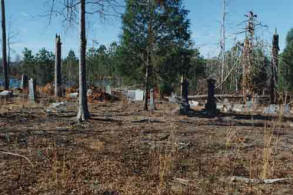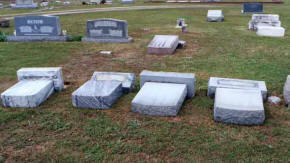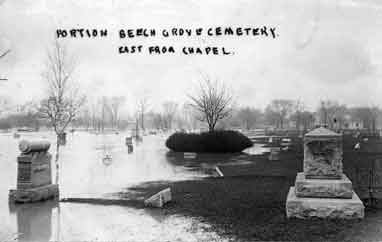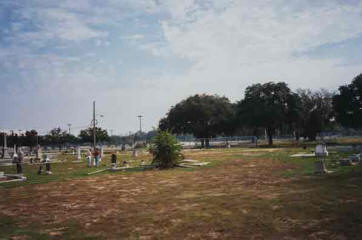|
What would you do if your cemetery suffered a disaster -- was hit by a
tornado, was flooded, was vandalized? Most cemetery caregivers are woefully
unprepared for a disaster. As a result cemeteries often never recover, or at
least never recover fully, from a disaster. This page will provide some quick
guidance for before and after.
Before the disaster
Wind damage (tornado, hurricane, trees)
Vandalism (toppled stones, stolen items, automobile accidents)
Flooding
Where to go for help
Before the Disaster
Too often no special steps are taken to prepare a cemetery for
problems. As a caregiver you have a very special responsibility to be prepared -- to
mitigate the effects of any potential disaster, thereby lessening the affects.
Through documentation. This means
having a map showing each and every stone, walkway, road, drain, water line, or
other feature. You will need this to plan recovery and repair efforts, to know
for certain that a particular stone is missing, to ensure that recovery efforts
don't cause additional damage. It also means have photographs and documentation
for the individual stones and features (such as gates). This will help determine
the extent of the damage and the need for repair. If a stone or cemetery gate is
stolen the photograph will be essential for reporting the loss and helping law
enforcement in efforts to recover the stolen items.
Hardening the target. While
you can't prevent all damages, you can take proactive steps to minimize some
losses. Ensure that stones are well-set and that
gates are secured.
Contact the cemetery's neighbors and ask their assistance in overseeing what
goes on in the cemetery -- ask them to be extra eyes and ears. Install bollards
at fences immediately bordering roads or at corners.
Daily inspections. This will
ensure that you immediately identify any problem -- man-made or natural. You
will know within a very narrow range of time when a gate was stolen or when a
stone was vandalized. Your periodic presence in the cemetery will deter much
vandalism.
Careful maintenance. Having a
certified
arborist yearly evaluate your cemetery's trees and their needs, do
preventative pruning, and maintain the health of the trees will help ensure that
there is minimal wind damage.
Know who to call. Make certain
that you are familiar with the help that is available. For example, become
familiar with how FEMA operates and the possibility of having federal assistance
to repair a cemetery if it is damaged in a Presidentially declared disaster.
Know how to report vandalism or theft and make certain there is a procedure in
place to document the loss and the report (here
is a form to help). And have a media plan in place --
explain to the community the loss and what they can do to help your cemetery
recover. It is also good practice to have a conservator
on-call. This is standard practice with museums, libraries, and archives since
it helps ensure that you get quick response when you need it most - a
conservator can assist with a stone-by-stone assessment, evaluation of landscape
damage, even with the recovery of your cemetery business records.
Wind Damage
Examples of wind damage include up-rooting of trees or downed
branches -- often with damage (breakage or toppling) to stones, fences, or other
features. Tornadoes can actually move (or even remove) stones. Other damage can
occur through improper clean-up.
Immediately assess the damage on a
stone-by-stone or feature-by-feature basis. You must have explicit
information concerning the number of broken stones, missing stones, collapsed
box tombs, downed trees, topped trees, downed limbs, etc.
Photograph the damage. You will
want to photograph the damage in order to have clear documentation of your
cemetery's losses. These photos may be used to help apply for funding from FEMA,
provide documentation for individual family insurance claims, or even by the
media in fundraising efforts. They will also be essential for a conservator to
begin to prepare treatment plans for repair of stones or fences.
Avoid additional damage during clean-up.
Don't make a bad situation worse by inappropriate clean-up efforts. Don't allow
trash collection vehicles on-site if the soils are wet or the vehicles begin to
bog-down. As a general rule all vehicles should remain on pre-existing roadways
and downed timber should be hand carried to the vehicles. Ensure that all stones
and fences (whether intact or damaged) are protected. This may necessitate the
use of canvas covers or even timber cribbing. Make certain that you use only
certified
arborists with specialized training and equipment to removed damaged trees
without injury to the stones. Make certain that they are appropriated bonded and
injured. Never pay for any clean-up up-front -- and get a signed contract that
specifies exactly what will be done and how you expect the work to take place.
Always save all fragments -- throw away
nothing! Just because a stone is shattered doesn't mean that it can't be
repaired. But the repair will be much more costly if parts are thrown away -- or
run over by heavy equipment. Everything should be carefully gathered up and --
as far as possible -- identified as to source. All these materials must be
carefully safeguarded until conservation treatments can begin on the site.
Recovery must be holistic. You
will need to think not just about the repair of stones, but also about the
landscape. How will you repair the loss of trees (what trees will be replanted
and where)? What repairs may need to be made to the roadways after debris
removal is complete? Your goal should be to return the cemetery to as near
original condition as possible.
Vandalism
Immediately contact law enforcement and
safeguard the crime scene. That's right -- your cemetery has become a
crime scene and you need to ensure that tire prints in the soft grass, discarded
cans of spray paint, trash that might contain a name, remains intact and
untouched. You may also need to insist that law enforcement treat vandalism as
the crime (typically a felony) that it is. You may even need to be willing to
contact your media, perhaps even your state police, to have evidence collected.
Do not give up, do not be bullied -- you and your cemetery are the victims,
expect to be treated with respect and be given immediate attention. Then keep
the pressure on your law enforcement to solve the case.
A list of law enforcement sites can
be found here. This is an alternative
site.
Be willing to prosecute and demand
justice. If you are fortunate enough to find the vandals, demand justice.
Demand that the case be prosecuted with vigor. Local citizens with family
buried in the cemetery should be called on to go to court to make a clear
statement to the presiding judge that this is a crime against the community and
you expect justice. Demand restitution from the criminals. If the case must be
pled down make certain that your cemetery's interested are respected. Involve
the media at every step -- make certain that future vandals are aware that they
will be caught, they will be prosecuted, and they will pay.

Immediately assess the damage on a
stone-by-stone or feature-by-feature basis. Once the crime scene
investigation is complete you must have explicit information concerning the
number of broken stones, missing stones, stolen gates, spray painted items, etc.
Photograph the damage. You will
want to photograph the damage in order to have clear documentation of your
cemetery's losses. These photos may provide documentation for individual family
insurance claims, or by the media in fundraising efforts. They will also be
essential for a conservator to begin to prepare treatment plans for repair of
stones or fences.
As quickly as possible, repair the
damage. The longer you leave vandalism unattended the greater the
likelihood that there will be more. Immediate repairs make it clear that the
cemetery is respected, has a constituency, and is being cared for. Leaving
damage unattended will also make future repairs harder -- stone fragments
disappear, paint gets harder to remove, and people lose interest.
Learn from the problem. What
allowed the vandalism to happen and what can you do to minimize future similar
experiences? If a gate was stolen, then you need to secure all remaining gates.
If stones were toppled, you need to better patrol the cemetery, using local law
enforcement, volunteers, and neighbors. If you ignore vandalism, it will return.
Flooding
Understand the threat. If your
cemetery is in a floodway, have you considered birms to redirect water? Are your
drains kept clear at all times? If you have particularly valuable markers
or gates, do you have steps in place to guard them against damage from slowly
rising flood waters? Understand, too, that flooding damage may involve sinkholes
(where sections of your cemetery may simply disappear), mechanical damage as
flood waters topple or shift stones (causing damage to the initial stone, as
well as damage to other stones it may strike), heavy trash and mud deposits (as
the flood waters recede, they will leave everything they were carrying with them
-- and this can be quite disgusting), and damage to vaults, coffins, and human
remains (vaults and coffins may be washed out of graves or may float; coffins
may burst, exposing human remains; human remains may be displaced considerable
distances from the cemetery). Some of these damages may pose public health
threats and will involve various agencies tasked with the recovery,
identification, and reburial of human remains.
Immediately assess the damage on a
stone-by-stone or feature-by-feature basis. You must have explicit
information concerning the number of broken stones, toppled stones, displaced
stones, silt covered sections of the grounds, toppled trees, etc.
 Photograph the damage. You will
want to photograph the damage in order to have clear documentation of your
cemetery's losses. These photos may provide documentation for individual family
insurance claims, to FEMA if the flooding is a declared disaster, or by the
media in fundraising efforts. They will also be essential for a conservator to
begin to prepare treatment plans for repair of stones or fences. Photograph the damage. You will
want to photograph the damage in order to have clear documentation of your
cemetery's losses. These photos may provide documentation for individual family
insurance claims, to FEMA if the flooding is a declared disaster, or by the
media in fundraising efforts. They will also be essential for a conservator to
begin to prepare treatment plans for repair of stones or fences.
Begin clean-up of debris. You
will want to remove sediment from roadways to allow recovery vehicles back in
the cemetery. You must remove sediments from drains to help prevent future
flooding by water with nowhere to go. You will need to begin collecting all of
the debris that was left by the flood waters -- tires, plastic bags, cans,
furniture. All this will require contracting with removal services, but be
certain that no heavy equipment is operated off roadways -- it will bog down and
cause extensive additional damage.
Involve engineers if necessary.
If the flooding resulted in extensive geological damage, such as a sink hole,
you will need to involve engineers with specialized skills to make the necessary
repairs. Failure to do so will likely cause the continued loss of your cemetery
and pose a threat to the public.
Always save all fragments -- throw away
nothing! Just because a stone is shattered doesn't mean that it can't be
repaired. But the repair will be much more costly if parts are thrown away -- or
run over by heavy equipment. Everything should be carefully gathered up and --
as far as possible -- identified as to source. All these materials must be
carefully safeguarded until conservation treatments can begin on the site.
Repair the damage. Involve a
trained stone conservator to conduct the needed treatment of stones -- repairs
and resetting. This individual can also guide you in other repairs -- such as
masonry repairs to walls or box tombs. A trained conservator can also oversee
the resetting of large monuments by a commercial firm, making certain that the
work is conducted in a manner that safeguards the stone.
Don't forget the landscape.
Floods will likely cause extensive damage to the landscape -- covering and
killing grass, downing trees, and destroying shrubbery. If the landscape is not
also repaired, much of the historical integrity of your cemetery will be lost.
Where to Go for Help
If the damage is caused by a Presidentially declared disaster,
then FEMA funds may be available to help public (city, county or state) and
non-profit cemeteries clean-up, remove debris, and make repairs. There are
several FEMA documents that you should be familiar with. One involves an
overview of FEMA assistance
programs,
FEMA
assistance specific to non-profits (such as cemeteries), and
FEMA coverage for collections
and individual objects.
This form, developed by the National Center for
Preservation Technology and Training (NCPTT) may help in conducting a quick
assessment of damage.
Your local
State Historic Preservation Office
(SHPO) may be able to provide additional
assistance or grants. Unfortunately, relatively few SHPOs have personnel with
specific knowledge of cemetery preservation.
An alternate list of
SHPOs is available here.
Chicora Foundation will also be happy to provide treatment
proposals for stone and ironwork that may have been damaged at the cemetery.
Contact us at 803-787-6910 or by email.
|